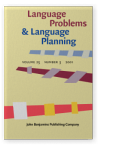Vol. 25:3 (2001) ► pp.237–257
Autonomy as a remedy for language conflict
Negotiating territoriality and identity
Group autonomy is often invoked as a tool to accommodate linguistic diversity and remedy potential conflicts in multilingual societies. This article analyses two different models of autonomy — namely the territorial and personal models — and assesses their ability to adequately respond to demands of linguistic recognition. Each model offers a mechanism for drawing internal boundaries within a given state in a way in which diverse linguistic groups can coexist. But while the territorial model draws internal boundaries in terms of concrete geographic lines, the personal model defines internal boundaries within a state in terms of more abstract lines of identity and group-membership. Analysis of the two models shows that although both models have strengths, they also have limitations. This creates a need to look for ways of integrating the two models such that they complement each other and overcome the limitations inherent in each. But the tension between the two models presents a challenge. As a solution, an asymmetrical integration, which gives precedence to territorial autonomy and supplements it with the personal model, is proposed.
Cited by (1)
Cited by 1 other publications
This list is based on CrossRef data as of 8 july 2024. Please note that it may not be complete. Sources presented here have been supplied by the respective publishers. Any errors therein should be reported to them.
